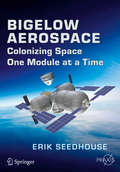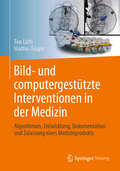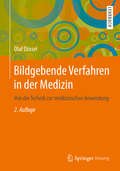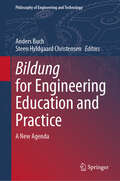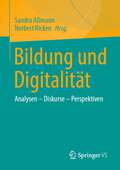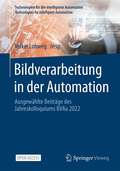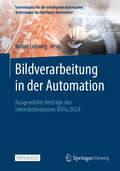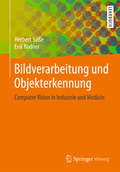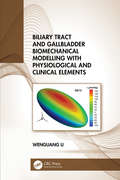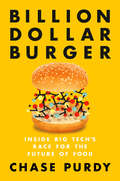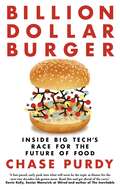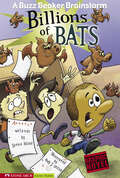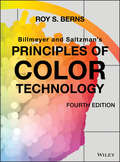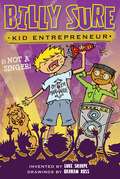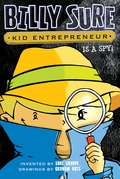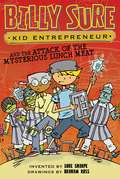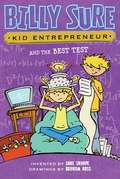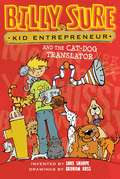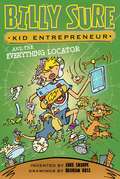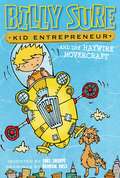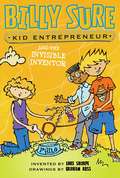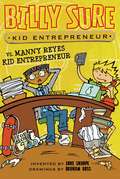- Table View
- List View
Bigelow Aerospace: Colonizing Space One Module at a Time (Springer Praxis Books)
by Erik SeedhouseHere for the first time you can read: how a space technology start-up is pioneering work on expandable space station modules how Robert Bigelow licensed the TransHab idea from NASA, and how his company developed the technology for more than a decade how, very soon, a Bigelow expandable module will be docked with the International Space Station. At the core of Bigelow's plan is the inflatable module technology. Tougher and more durable than their rigid counterparts, these inflatable modules are perfectly suited for use in the space, where Bigelow plans to link them together to form commercial space stations. This book describes how this new breed of space stations will be built and how the link between Bigelow Aerospace, NASA and private companies can lead to a new economy--a space economy. Finally, the book touches on Bigelow's aspirations beyond low Earth orbit, plans that include the landing of a base on the lunar surface and the prospect of missions to Mars.
Bikes and Bloomers: Victorian Women Inventors and their Extraordinary Cycle Wear (Goldsmiths Press Ser.)
by Kat JungnickelAn illustrated history of the evolution of British women's cycle wear.The bicycle in Victorian Britain is often celebrated as a vehicle of women's liberation. Less noted is another critical technology with which women forged new and mobile public lives—cycle wear. This illustrated account of women's cycle wear from Goldsmiths Press brings together Victorian engineering and radical feminist invention to supply a missing chapter in the history of feminism.Despite its benefits, cycling was a material and ideological minefield for women. Conventional fashions were unworkable, with skirts catching in wheels and tangling in pedals. Yet wearing “rational” cycle wear could provoke verbal and sometimes physical abuse from those threatened by newly mobile women. Seeking a solution, pioneering women not only imagined, made, and wore radical new forms of cycle wear but also patented their inventive designs. The most remarkable of these were convertible costumes that enabled wearers to transform ordinary clothing into cycle wear.Drawing on in-depth archival research and inventive practice, Kat Jungnickel brings to life in rich detail the little-known stories of six inventors of the 1890s. Alice Bygrave, a dressmaker of Brixton, registered four patents for a skirt with a dual pulley system built into its seams. Julia Gill, a court dressmaker of Haverstock Hill, patented a skirt that drew material up the waist using a mechanism of rings or eyelets. Mary and Sarah Pease, sisters from York, patented a skirt that could be quickly converted into a fashionable high-collar cape. Henrietta Müller, a women's rights activist of Maidenhead, patented a three-part cycling suit with a concealed system of loops and buttons to elevate the skirt. And Mary Ann Ward, a gentlewoman of Bristol, patented the “Hyde Park Safety Skirt,” which gathered fabric at intervals using a series of side buttons on the skirt. Their unique contributions to cycling's past continue to shape urban life for contemporary mobile women.
Bild- und computergestützte Interventionen in der Medizin: Algorithmen, Entwicklung, Dokumentation und Zulassung eines Medizinprodukts
by Tim Christian Lüth Mattias Felix TrägerDieses Buch richtet sich an Ingenieure, Informatiker sowie interessierte Angehörige der medizinischen und pflegerischen Berufe. Es erklärt die Grundlagen und Anwendungen der computerassistierten- und robotergestützten Medizingeräte auf dem aktuellen Stand der Technik. Derartige Systeme haben in den letzten 20 Jahren revolutionäre positive Veränderungen in der Radiologie, bei Interventionen und in vielen Gebieten der Chirurgie bewirkt. Mit dieser Technik ist es möglich, Bilddaten aus unterschiedlichen bildgebenden Systemen – wie z.B. Computertomograph, Ultraschall-gerät oder Videoendoskop – zu fusionieren, am Bildschirm dreidimensional darzustellen und darin mit dem Computer Eingriffe zu planen. Während der Operation wird die räumliche Lage des navigierten Instruments gemessen und im 3D-Modell des Patienten am Bildschirm dargestellt. Geplante Pfade der Instrumente werden eingeblendet, es wird vor Risiken bei Abweichungen von der Planung gewarnt und es können aktive Instrumente wie Bohrer, Fräser, Laser oder sogar Roboter automatisiert gesteuert werden. Die Autoren sind auf diesem Gebiet seit über 25 Jahren sowohl wissenschaftlich als auch unternehmerisch international führend tätig, weshalb in diesem Buch auch Entwicklungsmethodik, Dokumentation, Zulassung und Inverkehrbringung als Medizinprodukt praxisnah erläutert werden.
Bildgebende Verfahren in der Medizin: Von der Technik zur medizinischen Anwendung
by Olaf DösselDieses erfolgreiche Standardwerk beschreibt s#65533;mtliche bildgebenden Verfahren von der R#65533;ntgentechnik #65533;ber den Ultraschall bis zu den Methoden der Tomographie. Es werden sowohl die technischen Grundlagen als auch die medizinischen Anwendungen erl#65533;utert. Das Lehrbuch zeichnet sich aus durch eine verst#65533;ndliche Darstellung, zahlreiche Illustrationen der grundlegenden Prinzipien sowie durch Bilder von den verschiedenen Modalit#65533;ten und von den Ger#65533;ten. Die 2. Auflage wurde aktualisiert und enth#65533;lt neue Trends und Entwicklungen, insbesondere beim R#65533;ntgen und Ultraschall. Kapitel #65533;ber Magnetic Particle Imaging (MPI) wurden hinzugef#65533;gt.
Bildung for Engineering Education and Practice: A New Agenda (Philosophy of Engineering and Technology #49)
by Steen Hyldgaard Christensen Anders BuchUsing the concept of Bildung as a framework, which in late capitalism/postmodernity may be perceived to include critical knowledge, value consciousness, ethics, and social responsibility (including sustainability), this project aims to investigate the underlying aspirations, structures, and dynamics of change taking place in engineering education and practice through conversations between engineering, social sciences, and the humanities. Calling upon the spirit of philosophers on Bildung such as John Dewey, Jürgen Habermas and contemporaries, the focus of the present project is on broadening engineering education initiatives and practice that follow normative understandings of Bildung. This volume appeals to researchers and students working in philosophy, engineering, and education.
Bildung und Digitalität: Analysen – Diskurse – Perspektiven
by Norbert Ricken Sandra AßmannMit ›Bildung‹ und ›Digitalität‹ wird ein intensiv diskutiertes Spannungsfeld markiert: Einerseits wird oft die ›digitale Rückständigkeit‹ von Schule beklagt, andererseits aber lassen sich auch pädagogische Skepsis und Hemmnisse nicht einfach übersehen. An dieser Spannung setzen die Beiträge des Bandes an und fragen sowohl nach den Herausforderungen der ›Bildung‹ durch ›Digitalität‹ als auch umgekehrt nach den Anforderungen an ›Digitalität› durch ›Bildung‹. Das macht aber nötig, ›Digitalisierung‹ nicht bloß als (gar technische) Anwendungsproblematik und didaktische Herausforderung aufzunehmen, sondern auch (grundlagen-)theoretisch zu reflektieren. Dabei werden entlang der Fragen nach den jeweiligen Medien-, Subjekt- und Wissensformationen des ›Digitalen‹ auch Konturen eines pädagogischen Strukturwandels erkennbar und diskutierbar.
Bildverarbeitung in der Automation: Ausgewählte Beiträge des Jahreskolloquiums BVAu 2022 (Technologien für die intelligente Automation #17)
by Volker LohwegIn diesem Open-Access-Tagungsband sind die besten Beiträge des 8. Jahreskolloquiums "Bildverarbeitung in der Automation" (BVAu 2022) enthalten. Das Kolloquium fand am 02. November 2022 auf dem Innovation Campus Lemgo statt.Die vorgestellten neuesten Forschungsergebnisse auf den Gebieten der industriellen Bildverarbeitung erweitern den aktuellen Stand der Forschung und Technik. Die in den Beiträgen enthaltenen anschaulichen Anwendungsbeispiele aus dem Bereich der Automation setzen die Ergebnisse in den direkten Anwendungsbezug.
Bildverarbeitung in der Automation: Ausgewählte Beiträge des Jahreskolloquiums BVAu 2024 (Technologien für die intelligente Automation #19)
by Volker LohwegIn diesem Open-Access-Tagungsband sind die besten Beiträge des 9. Jahreskolloquiums "Bildverarbeitung in der Automation" (BVAu 2024) enthalten. Das Kolloquium fand am 05. November 2024 auf dem Innovation Campus Lemgo statt. Die vorgestellten neuesten Forschungsergebnisse auf den Gebieten der industriellen Bildverarbeitung erweitern den aktuellen Stand der Forschung und Technik. Die in den Beiträgen enthaltenen anschaulichen Anwendungsbeispiele aus dem Bereich der Automation setzen die Ergebnisse in den direkten Anwendungsbezug.
Bildverarbeitung und Objekterkennung: Computer Vision in Industrie und Medizin
by Herbert Süße Erik RodnerDieses Buch erläutert, wie Informationen automatisch aus Bildern extrahiert werden. Mit dieser sehr aktuellen Frage beschäftigt sich das Buch mittels eines Streifzuges durch die Bildverarbeitung. Dabei werden sowohl die mathematischen Grundlagen vieler Verfahren der 2D- und 3D-Bildanalyse vermittelt als auch deren Nutzen anhand von Problemstellungen aus vielen Bereichen (Medizin, industrielle Bildverarbeitung, Objekterkennung) erläutert. Das Buch eignet sich sowohl für Studierende der Informatik, Mathematik und Ingenieurwissenschaften als auch für Anwender aus der industriellen Bildverarbeitung.
Biliary Tract and Gallbladder Biomechanical Modelling with Physiological and Clinical Elements
by Wenguang LiGallstone and other diseases of the biliary tract affect more than around 20% of the adult population. The complications of gallstones, acute pancreatitis and obstructive jaundice, can be lethal. This is the first book to systematically treat biliary tract and gallbladder modelling with physiological and clinical information in a biomechanical context. The book provides readers with detailed biomechanical modelling procedures for the biliary tract and gallbladder based on physiological information, clinical observations and experimental data and with the results properly interpreted in terms of clinical diagnosis and with biomechanical mechanisms for biliary diseases. The text can be used as a reference book for university undergraduates, postgraduates and professional researchers in applied mathematics, biomechanics, biomechanical engineering and biomedical engineering, as well as related surgeons.
Billion Dollar Burger: Inside Big Tech's Race for the Future of Food
by Chase PurdyThe riveting story of the entrepreneurs and renegades fighting to bring lab-grown meat to the world.The trillion-dollar meat industry is one of our greatest environmental hazards; it pollutes more than all the world's fossil-fuel-powered cars. Global animal agriculture is responsible for deforestation, soil erosion, and more emissions than air travel, paper mills, and coal mining combined. It also, of course, depends on the slaughter of more than 60 billion animals per year, a number that is only increasing as the global appetite for meat swells. But a band of doctors, scientists, activists, and entrepreneurs have been racing to end animal agriculture as we know it, hoping to fulfill a dream of creating meat without ever having to kill an animal. In the laboratories of Silicon Valley companies, Dutch universities, and Israeli startups, visionaries are growing burgers and steaks from microscopic animal cells and inventing systems to do so at scale--allowing us to feed the world without slaughter and environmental devastation. Drawing from exclusive and unprecedented access to the main players, from polarizing activist-turned-tech CEO Josh Tetrick to lobbyists and regulators on both sides of the issue, Billion Dollar Burger follows the people fighting to upend our food system as they butt up against the entrenched interests fighting viciously to stop them. The stakes are monumentally high: cell-cultured meat is the best hope for sustainable food production, a key to fighting climate change, a gold mine for the companies that make it happen, and an existential threat for the farmers and meatpackers that make our meat today. Are we ready?
Billion Dollar Burger: Inside Big Tech's Race for the Future of Food
by Chase PurdyA fast-paced, gripping insider account of the entrepreneurs and renegades racing to bring lab-grown meat to the world.The trillion-dollar meat industry is one of our greatest environmental hazards; it pollutes more than all the world's fossil-fuel-powered cars. Global animal agriculture is responsible for deforestation, soil erosion and more emissions than air travel, paper mills and coal mining combined. It also depends on the slaughter of more than 60 billion animals per year, a number that is only increasing as the global appetite for meat swells. The whole world seems to be sleepwalking into a food crisis. But a band of doctors, scientists, activists and entrepreneurs have been racing to end animal agriculture as we know it, hoping to fulfill a dream of creating meat without ever having to kill an animal. This is the story of a group of seven vegans quietly working to solve one the most pressing issues we face today, creating the biggest upheaval to the food business in decades along the way. In Billion Dollar Burger, Chase Purdy explores the companies at the cutting edge of the nascent food technology sector, from polarizing activist-turned-tech CEO Josh Tetrick to lobbyists and regulators on both sides of the issue. Billion Dollar Burger follows the people fighting to upend our food system as they butt up against the entrenched interests fighting viciously to stop them. It will take readers on a truly global journey from Silicon Valley to China, by way of Israel and the UK.The stakes are monumentally high: cell-cultured meat is the best hope for sustainable food production, a key to fighting climate change, a gold mine for the companies that make it happen and an existential threat for the farmers and meatpackers that make our meat today.
Billion Dollar Burger: Inside Big Tech's Race for the Future of Food
by Chase PurdyA fast-paced, gripping insider account of the entrepreneurs and renegades racing to bring lab-grown meat to the world.The trillion-dollar meat industry is one of our greatest environmental hazards; it pollutes more than all the world's fossil-fuel-powered cars. Global animal agriculture is responsible for deforestation, soil erosion and more emissions than air travel, paper mills and coal mining combined. It also depends on the slaughter of more than 60 billion animals per year, a number that is only increasing as the global appetite for meat swells. The whole world seems to be sleepwalking into a food crisis. But a band of doctors, scientists, activists and entrepreneurs have been racing to end animal agriculture as we know it, hoping to fulfill a dream of creating meat without ever having to kill an animal. This is the story of a group of seven vegans quietly working to solve one the most pressing issues we face today, creating the biggest upheaval to the food business in decades along the way. In Billion Dollar Burger, Chase Purdy explores the companies at the cutting edge of the nascent food technology sector, from polarizing activist-turned-tech CEO Josh Tetrick to lobbyists and regulators on both sides of the issue. Billion Dollar Burger follows the people fighting to upend our food system as they butt up against the entrenched interests fighting viciously to stop them. It will take readers on a truly global journey from Silicon Valley to China, by way of Israel and the UK.The stakes are monumentally high: cell-cultured meat is the best hope for sustainable food production, a key to fighting climate change, a gold mine for the companies that make it happen and an existential threat for the farmers and meatpackers that make our meat today.
Billions of Bats: A Buzz Beaker Brainstorm (A Buzz Beaker Brainstorm)
by Scott NickelWhen Sarah uses her pet bat to help show off her new cosmic copy machine to the class, something horrible goes wrong resulting in Buzz Beaker and Sarah having to save the day. Written in graphic-novel format.
Billmeyer and Saltzman's Principles of Color Technology
by Roy S. BernsThis book offers detailed coverage of color, colorants, the coloring of materials, and reproducing the color of materials through imaging. It combines the clarity and ease of earlier editions with significant updates about the advancement in color theory and technology. Provides guidance for how to use color measurement instrumentation, make a visual assessment, set a visual tolerance, and select a formulation Supplements material with numerical examples, graphs, and illustrations that clarify and explain complex subjects Expands coverage of topics including spatial vision, solid-state lighting, cameras and spectrophotometers, and translucent materials
Billy Sure Kid Entrepreneur Is NOT A SINGER!
by Graham Ross Luke SharpeBilly Sure is an inventor, the CEO of Sure Things, Inc., and a middle school student. But he is not a singer! How bad is he? Find out in the ninth book of a hilarious middle grade series!Everyone is talking about Billy Sure, the genius inventor and CEO of Sure Things, Inc. Billy went from ordinary kid with a dream to millionaire with his very own company when he created the All Ball. What is the All Ball? The All Ball is the only ball you'll ever need. With a push of a button, you can turn the All Ball into any sports ball. Comes in two sizes. Large: soccer, football, basketball, volleyball, bowling ball. Small: baseball, hockey puck, tennis ball, golf ball, Ping-Pong ball. Now Billy wants to help other kids achieve their dreams. Billy and Manny are thrilled to be guest judges on Sing Out and Shout, everyone's favorite singing competition TV show--that is, until they find out they're not judges, they're contestants! When Manny sings, everyone cheers. But when Billy takes the stage, his voice CRACKS! and breaks a mirror! How will Billy survive the competition? Could inventing a Magical Microphone do the trick? Find out in this wacky story with funny black-and-white illustrations throughout.
Billy Sure Kid Entrepreneur Is a Spy!
by Graham Ross Luke SharpeBilly Sure, kid inventor and CEO of Sure Things, Inc., discovers a big secret about his mom in the sixth book of a hilarious middle grade series!Billy's mom has always claimed she is a scientist doing research for the government, but he's always suspected that there was more to the story. And as it turns out, he was right! His mom is a spy, and now she has enrolled him in spy school so he can create inventions for her top-secret spy unit. Billy is thrilled, especially because he gets to try out all of the awesome spy gadgets and meet three other super smart spy kids. But when Billy is offered a chance to become a spy himself, he has a big decision to make. Does he want to become the world's youngest spy...or is it enough just to be Billy Sure, Kid Entrepreneur?
Billy Sure Kid Entrepreneur and the Attack of the Mysterious Lunch Meat
by Graham Ross Luke SharpeThe students at Fillmore Middle School have turned into zombies and it’s up to Billy to invent something that can turn them back in the twelfth book of a hilarious middle grade series!There’s something mysterious oozing its way down the Fillmore Middle School cafeteria, and yup—it’s more mysterious than normal! There’s a new lunch lady in charge, and her menu is so terrible it can’t be solved with a sprinkle of Gross-to-Good Powder. But there’s something even worse than disgusting school lunch happening. Everyone who eats the new food turns into a zombie! First Petula Brown, then Peter MacHale, then—oh no, Manny? Billy’s got to invent something to stop the attack of the evil lunch meat, but could this be a food fight that Sure Things, Inc. can’t win? Find out in this wacky story with funny black-and-white illustrations throughout.
Billy Sure Kid Entrepreneur and the Best Test
by Graham Ross Luke SharpeBilly Sure, twelve-year-old inventor and CEO of Sure Things, Inc., has come up with another zany invention that tells you what you're best at in the fourth book of a hilarious middle grade series!Everyone is talking about Billy Sure, the twelve-year-old genius and millionaire inventor whose inventions have become instant hits. Billy's lucky because in addition to being a rich and famous inventor, he already knows what he's best at: inventing, of course! He wants to help other kids figure out what they're best at too, and his latest invention--The Best Test--will do just that! But when Billy takes the test himself and the results come back saying he isn't the best at inventing, and what he's best at has nothing to do with inventing at all, he begins to wonder who is. And what that means for the future of Sure Things, Inc.
Billy Sure Kid Entrepreneur and the Cat-Dog Translator
by Graham Ross Luke SharpeBilly Sure, twelve-year-old inventor and CEO of Sure Things, Inc., invents a device that lets everyone in on what their pets are trying to say in the third book of a hilarious middle grade series!Everyone is talking about Billy Sure, the twelve-year-old genius and millionaire inventor whose inventions have become instant hits. From the All Ball and the Sibling Silencer, to the Stink Spectacular and the Disappearing Reappearing Make-Up, Billy Sure can't lose--and his latest invention, the Cat-Dog Translator, is sure to follow suit. After all, who hasn't wondered what their cat's meow or their dog's bark meant? The Cat-Dog Translator is a device that will finally let pet owners in on what their pets are really trying to say. But Billy quickly finds out, when pets start talking, there's no telling what kinds of embarrassing secrets they could reveal! Is the world ready for Billy Sure to unleash his latest invention?
Billy Sure Kid Entrepreneur and the Everything Locator
by Graham Ross Luke SharpeBilly Sure, inventor and CEO of Sure Things, Inc., invents a device that can track down everything--and we mean everything--he's ever lost in the tenth book of a hilarious middle grade series!What's a kid entrepreneur to do when he loses his math homework? Invent the Everything Locator, of course! Billy's next invention is a device that will find any lost item and return it to you. But the Everything Locator has one teeny, tiny problem...it returns every item that Billy has ever lost, all at once! Will Billy find a way to make everything right with the Everything Locator? Will he even be able to dig his way out of this pile of junk? Find out in this wacky story with funny black-and-white illustrations throughout.
Billy Sure Kid Entrepreneur and the Haywire Hovercraft
by Graham Ross Luke SharpeBilly Sure, inventor and CEO of Sure Things, Inc., must track down a haywire hovercraft that's gone missing with his sister on board in the seventh book of a hilarious middle grade series!Everyone is talking about Billy Sure, the boy genius and millionaire inventor whose inventions have become instant hits. From the All Ball that turns into any sports ball to the Gross-to-Good Powder that makes even the most disgusting foods taste great, Sure Things, Inc. can do no wrong! Now Billy wants to help other kids achieve their inventing dreams, so he solicits and selects new ideas to develop. Billy and Manny know exactly what Sure Things, Inc.'s Next Big Thing will be--a hovercraft! But when they start to build it, they notice it's a little...haywire. The hovercraft dips, dives, twirls, and spins, until one day, it's gone entirely, and so is Emily! Can Billy find his sister and fix the hovercraft, or will this be a crash landing for Sure Things, Inc.? Find out in this wacky story with funny black-and-white spot illustrations throughout!
Billy Sure Kid Entrepreneur and the Invisible Inventor
by Graham Ross Luke SharpeBilly Sure, inventor and CEO of Sure Things, Inc., is in a race to finish his invisibility spray before another inventor gets all the glory in the eighth book of a hilarious middle grade series!Everyone is talking about Billy Sure, the boy genius and millionaire inventor whose inventions have become instant hits. From the All Ball that turns into any sports ball to his hovercraft, Sure Things, Inc. can do no wrong! Now Billy wants to help other kids achieve their inventing dreams, so he solicits and selects new ideas to develop. Billy has been working on an invisibility invention for years--but it isn't quite right yet. Now suddenly there's a new inventor on the scene who claims to have developed it first. But it might not be all it's cracked up to be. Will Billy's dream of creating the world's first invisibility spray disappear? Find out in this wacky story with funny black-and-white illustrations throughout.
Billy Sure Kid Entrepreneur and the No-Trouble Bubble
by Graham Ross Luke SharpeBilly Sure, twelve-year-old inventor and CEO of Sure Things, Inc., hosts a competition to find the Next Big Thing in the fifth book of a hilarious middle grade series!Everyone is talking about Billy Sure, the twelve-year-old genius and millionaire inventor whose inventions have become instant hits. From the All Ball that turns into any sports ball to the Gross-to-Good Powder that makes even the most disgusting foods taste great, Sure Things, Inc. can do no wrong! But what's next for Billy and his business partner Manny? They're looking for a new challenge, and hosting a televised special to find Sure Things, Inc.'s Next Big Thing is just the thing! Thousands of kids pile into the studio to present their invention ideas to Billy. Some are wacky, some are wild, and some have the potential to change the world as we know it. And the winner is...
Billy Sure Kid Entrepreneur vs. Manny Reyes Kid Entrepreneur
by Graham Ross Luke SharpeBilly Sure and Manny Reyes switch jobs at Sure Things, Inc. in the eleventh book of a hilarious middle grade series!Meet Manny Reyes, inventor and CEO of Sure Things, Inc….wait, what?! It’s a friendly switcheroo at Sure Things, Inc.! Manny decides to roll out Sure Things, Inc.’s Next Big Thing—the Candy Toothbrush. Of course every good inventor needs a good CFO, so Billy steps up to the plate. But is Manny a better kid inventor than Billy? And does Sure Things, Inc. have room for the both of them? Find out in this wacky story with funny black-and-white illustrations throughout.
